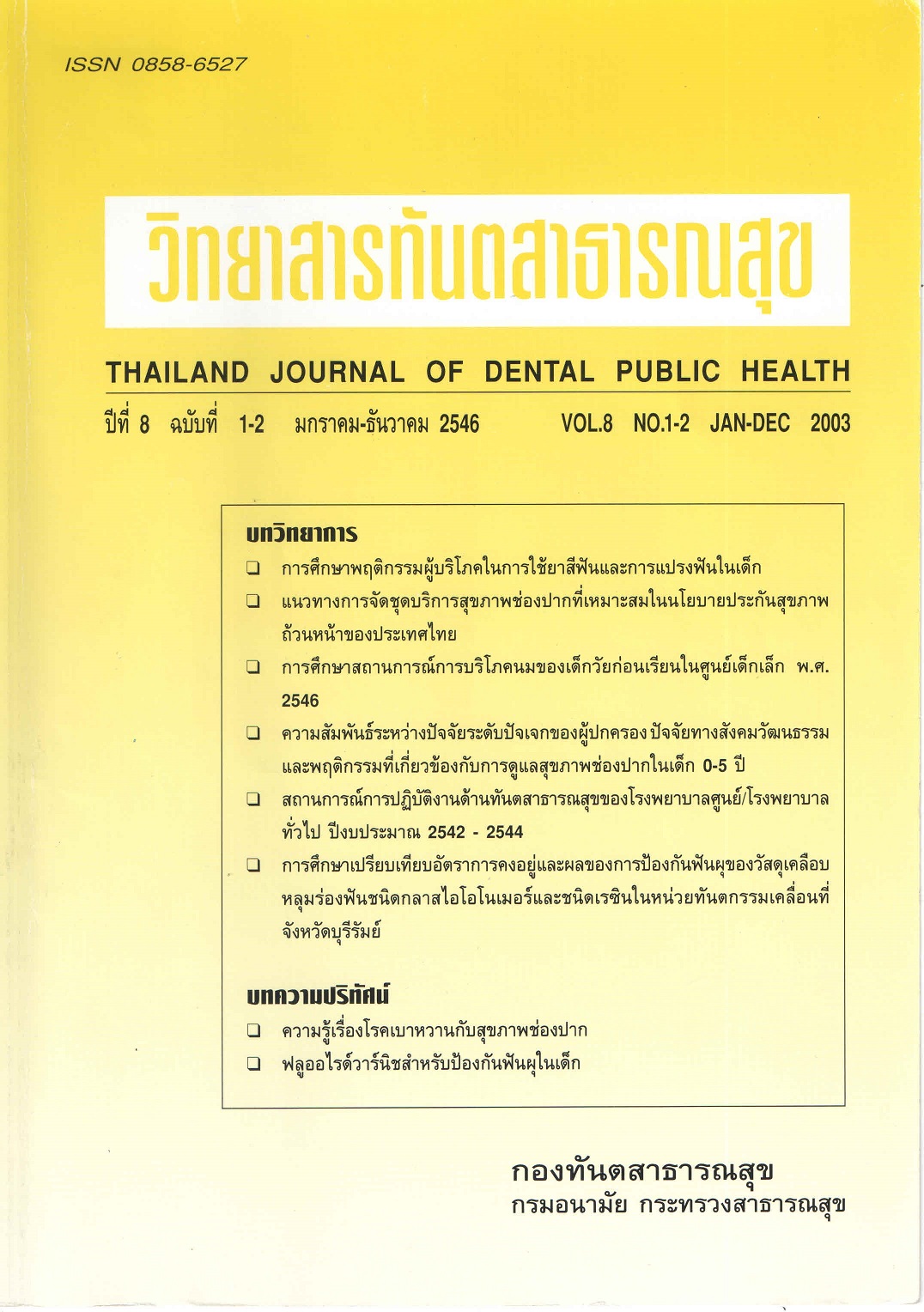Articles The comparative study on retention rate and caries prevention between Glassionomer and Resin using as pit and fissure sealant in mobile dental service, Buriram province.
Main Article Content
Abstract
The objective of this study was to evaluate the retention rate and dental caries rate after sealing with resin and glassionomer for decision making of choosing the proper sealant material used in mobile dental service.
Randomized controled trial study was prepared, The sample were 120 children age of 6 - 7 year, the first 60 children received glassionomer sealing at #36 and resin sealing at #46 and the other group was sealed opposite.
No treatment was prepared in the opposite teeth for comparing the dental caries rate. Follow up at 1 and 2 year, Using chi-square for analysis.
The percentage of the first and second year data collecting showed as 89.16 and 84.16 respectively. The retention rate of resin and glassionomer at 1 year are 19.6% and 22.42% respectively. At 2 years, there were 8.9% and 12.8% respectively and no significant statistical difference (P > 0.05)
The caries rate at 1 year of resin and glassionomer group were 24.3% and 12.1% respectively, at the second year were 44.55% and 20.80% respectively, there was significant statistical difference at P < 0.05 as the resin sealed teeth had higher dental caries rate two times than glassionomer sealed teeth. At 1 year dental caries rate of upper teeth was 36.9% and the lower teeth was 18.2%. There was significant statistical difference (P < 0.05) as the upper teeth had higher dental caries rate two times than the lower one. However at 2 years, there was no significant statistical difference. The factors that affected to retention rate of the two materials were operators, moisture, effectiveness of equipment. The lower dental caries rate of glassionomer sealed teeth group might have come from the influence of fluoride substance in glasionomer material that useful for dental caries prevention.
Downloads
Article Details
References
(2) กองทันตสาธารณสุข กรมอนามัย กระทรวงสาธารณสุข “สารเคลือบหลุมร่องฟันในงานทันตกรรม” พ.ศ.2536
(3) Simonsen RJ. : Pit and fissure sealant in individual patient care programs. J.Dent. Educ 48 (Suppl.) : 42, 1984
(4) Raadal M.et all. : Fissure sealing with a light - cured resin - reinforced glass-ionomer cement. (Vitrebond.) compared with a resin sealant. International journal of paediatric Dentistry. 1996 : 6 : 235-239.
(5) ประทีป พันธุมวนิช ; คู่มือการบูรณะฟัน โดยสูญเสียเนื้อฟันน้อยที่สุด, เอกสารประกอบการอบรม, 2537.
(6) Frencken JB., Makoni. F, Sithole W.D.: Atraumatic restorative treatment and glass-ionomer sealant in a school oral health programme in Zimbabwe : evaluation after 1 year. Caries Res. J. 1996; 30 : 428 - 433.
(7) Radike AW.: Criteria for diagnosis of dental caries. Proc Conf of Clinical testing of cariostatic agents. Chicago : American Dental Association, 1968 : 87 - 88.
(8) เรวดี ต่อประดิษฐ์ และคณะ : สภาวะโรคฟันผุเมื่อสํารวจด้วยเกณฑ์วัดโรคฟันผุก่อนมีรูผู้เปรียบเทียบเกณฑ์ที่แนะนำโดยองค์การอนามัยโลก.วิทยาสารทันตสาธารณสุข. พ.ศ.2542 ; 1:27-34.
(9) Pitts NB.: Diagnostic tools and measurements impact on appropriate care. Community Dent oral Epidemiol. 1997; 25: 24 - 35.
(10) Periva et all. : A comparison of caries Preventive effects and retention of resin and GIC sealants. J.Dent. Res. 1994 ; 74: 745.
(11) Songpaisan Y.et all. : Effect of glass-ionomer cement, resin based pit and fissure sealant and HF application of occlusal caries in a developing country field trial. Community Dent oral Epidemiol. 1995 ; 23 : 25 - 29.
(12) Gunlog KR et all. : A three years follow up of glass-ionomer cement and resin fissure sealant. Journal of Dentistry for children. 1995 ; March - April, 108 - 110.
(13) Mckenna (EF), Grundy GE : Glass-ionomer cement fissure sealants applied by operative dental auxiliaries-retention rate after one year. Aust Dent J. 1987; 32 : 200 - 203.
(14) Forss et all. : Comparison of glass-ionomer and resin based fissure sealant: a 2 year clinical trial. Community Dent oral Epidemiol 1994 : 22 : 21 - 24.
(15) Louise B.et all. : The retention of pit and fissure sealants placed in primary school children by Dental Health Services, Victoria. Australian Dental Journal. 1997; 42 : (4): 233 - 9.
(16) Arrow P.Riordan PJ. : Retention and Caries preventive effects of a GIC and a resin-based fissure sealant. Community Dent Oral Epideriol. 1995; 23: 282 - 285.
(17) Masato F.et all. : Early loss of pit and fissure sealant: a clinical and SEM study. The Journal of clinical Pediatric Dentistry. 1955 ; 19: 99 - 104.
(18) Amid I. Ismail. : Minimal Intervention Techniques for dental caries. J. of public health dentistry. 1996 ; 56 : 155 - 160.
(19) Willem E.V.: Dental caries under Glassionomer restoration. J. of public health dentistry. 1996 ; 56: 150 - 154.
(20) Martha. A, Franklin. GG. : Clinical evaluation of the retention and wear of a light-cured pit and fissure glass-ionomer sealant. The journal of clinical Pediatric Dentistry. 1995 ; 19 : 273 - 277.
(21) Koch G, Hatibovic-Kofman S. : Glassionomer cements as a fluoride release system invivo. Swed. Dent.J. 1990 ; 14: 267 - 273.
(22) Kevin J.Donly, Jeffrey J.Nelson. Fluoride release of restorative materials exposed to a fluoridated dentifrice.J. of dentistry for children. 1997; July - August : 249 - 250.
(23) Wensenberg G, Hals E. : The invitro effect of a glassionomer cement of dentine and enamel walls.J. oral Rehab. 1980 ; 7:35 - 42.
(24) Tantbirojn D., Donglas WH., Verslvis A. : Inhibitive effect of a resin-modified glassionmer cement on remote enamel artificial caries. Caries research J. 1997;31: 275 - 280.


